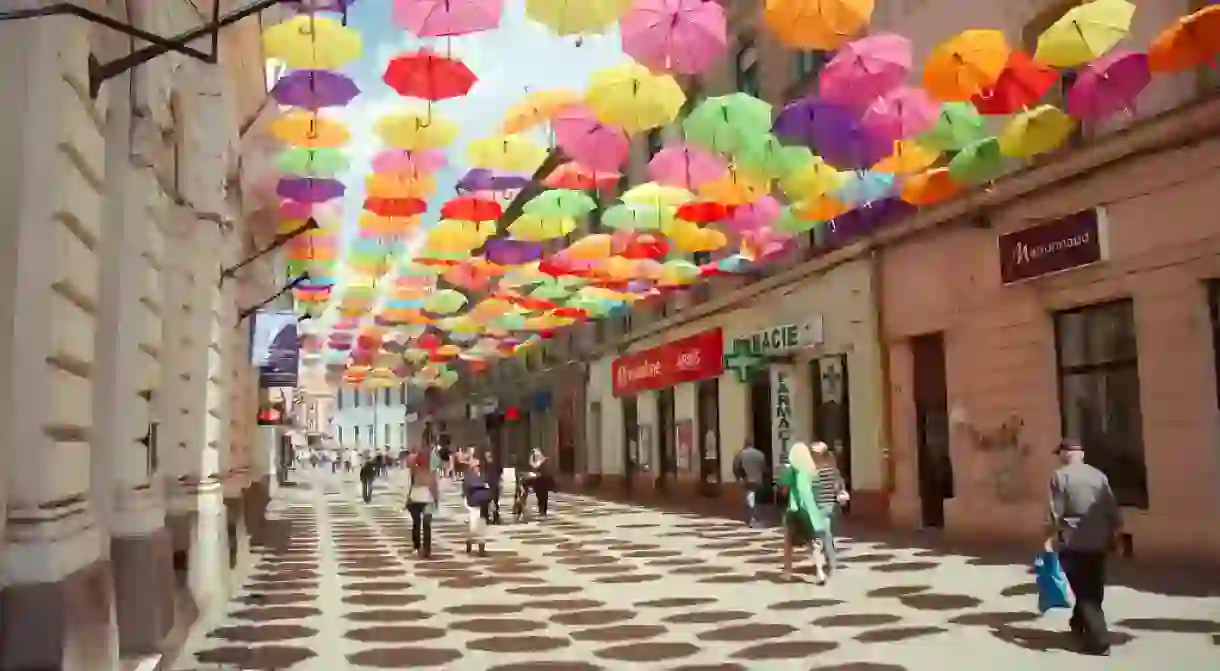10 Reasons to Visit Timișoara

With its rich history, vibrant cultural scene, lively terraces and cafés and robust student population, Timișoara, the 2021 European Capital of Culture is Romania’s must-visit city right now. Here are our 10 reasons why you should add Timișoara to your destination list on your next visit to Romania.
Fascinating history
Timișoara has been inhabited since ancient times, by Dacians and later the Romans, who named it Castrum Temesiense. First mentioned in 1212 as a citadel, by the 14th century it became an important outpost in the fight between Christendom and the Muslim Ottoman Turks. It was here that Hungarian and French crusaders gathered before the Battle of Nicopolis (1396), one of the last large scale crusades. From the 18th century, it developed around the fortified nucleus and later transitioned towards becoming an important economic and industrial centre. The city flourished between the interwar period and the Communist period, when its population tripled.
On 22 December 1989, following a popular uprising, Timișoara became the first Romanian city free of communism, starting the Romanian Revolution which toppled Ceaușescu’s regime.
https://www.instagram.com/p/BOUwNoHAF53/?tagged=revolutia1989
Electrifying past
The capital of the Banat region was also the second European city, and first in Romania, to introduce horse-drawn trams in 1869.
Lively cultural scene
The city also has several museums hosted by some of Timișoara’s landmark buildings. The Art Museum, hosted by the Baroque Palace in the Unirii Square, the Banat Museum that occupies the Huniade Castle, and the open-air Museum of Banat Villageare not to be missed. The Palace of the Serbian Episcopacy offers a surprisingly well curated collection of artand rare books. Plus, Timișoara also has an Opera, a Philarmonic, plenty of art galleries and hosts over 30 festivals every year.
University center
Ever since King Ferdinand I awarded Timișoara the status of University centre in 1920, the city has attracted the brightest minds in the country and beyond.
Timișoara now has four public universities and as many private ones. The student population of the city, totalling around 60,000 students, lends the city a fresh, youthful vibe.
https://www.instagram.com/p/BWnt75glPsk/?taken-at=240257335
2021 European Capital of Culture
In September 2016, Timișoara was elected 2021 European Capital of Culture, a title it shares with Novi Sad in Serbia and Eleusis, Greece. For one calendar year, the city will host a series of cultural events with a European dimension, such as exhibitions, concerts, plays and many more.
https://www.instagram.com/p/BVNUNVCg7s4/
True multiculturalism
Building, Opera House
Currently, the Romanian Opera House, the imposing building in Victoriei Square, hosts the Opera, as well as the Mihai Eminescu Romanian National Theatre, the German State Theatre and the Csiky Gergely Hungarian State Theatre. Moreover, services at the Catholic Dome are held even today in Romanian, Hungarian and German languages.
Stunning architecture
Standing tall at 80 meters, with its 11 towers, and seven bells, the Timișoara Metropolitan Cathedral is one of the most imposing buildings in the city. Its cupola is built in Moldavian style, while the side arches are in Byzantine style and the mosaic floors recreate motifs found in Banat style rugs. The City Hall and the Neuhaus Palace, designed by talented Hungarian-born architect Laszlo Szekely, add to the list of architectural landmarks of the city.
The Catholic Dome is the most important Baroque monument in the Banat region. Its sumptuous interior features nine altars decorated in rococo style, made by Viennese painters and sculptors. Not least, Art Nouveau buildings are scattered all around the area of the former citadel. The Dicasterial Palace, hosting the Palace of Justice, is a copy of the Palazzo Medici in Florence.
Amazing food
Cafe
Mild weather
Timișoara has mild weather all year round, thanks to its Marine West Coast Climate. This means that usually, at the height of summer, the city is spared the hot and dry days Bucharest and other cities in the Romanian Plain are known for. In winter, temperatures do not drop sharply, making the city an enjoyable destination to be explored by day and by night.
https://www.instagram.com/p/BUEe7MUBcjt/?tagged=timisoarabynight
Wild nature
Park













